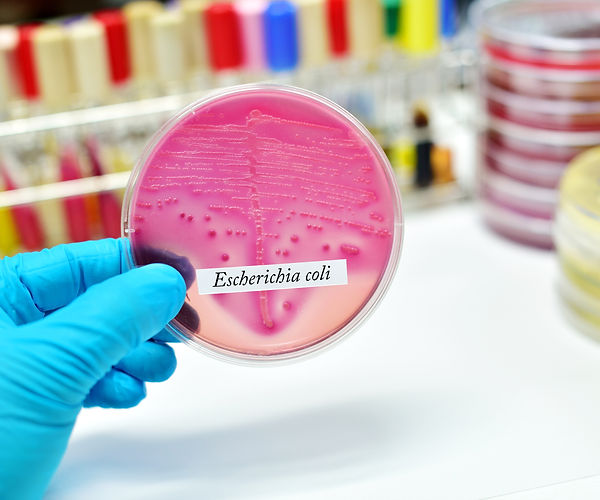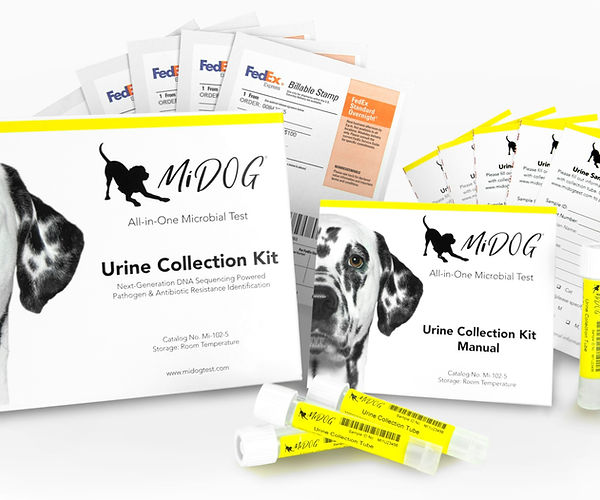
Escherichia coli infections can be difficult to diagnose in cats due to subclinical presentations.
If your cat has been struggling to use the litterbox, they might be suffering from a urinary tract infection (UTI)! While UTIs are less common in younger cats, these infections progress to feline lower urinary tract disorders in 40-45% of cats older than 10 years [1]. Feline urine even in a healthy state is not sterile, and is home to a plethora of bacteria; however, when pathogenic bacteria are able to outcompete healthy bacteria, urinary tract infections may manifest.
Escherichia coli has long been named the most common pathogenic isolate in feline urine, and is consequently associated with UTI manifestation [2]. UTIs have historically been one of the most common indications for antibiotic usage in veterinary medicine, which inadvertently contributes to antibiotic-resistant strains of bacteria [3]. Consequently, knowing the exact strain of bacteria and pathogenicity of that strain can have significant impacts on your pet’s health outcomes! If you suspect your furry friend is suffering from a UTI, visit a veterinarian as soon as possible to explore contemporary diagnostics and treatment options.
What is Escherichia coli?

The image above depicts Escherichia coli.
Escherichia coli is a Gram-negative, facultative anaerobic, rod-shaped, coliform bacterium that is often found in the lower intestine of warm-blooded organisms [2]. While most E. coli strains are harmless, specific serotypes can cause serious infections in their host and may even be resistant to certain antibiotics. Bacterial UTIs often result from normal skin and GI tract flora ascending the urinary tract and overcoming the normal urinary tract defenses that prevent pathogenic colonization. UTI rates are much higher in older cats, due to diminished host defenses from aging or other diseases, such as diabetes, renal failure, or hyperthyroidism [1, 4]. While feline UTI severity exists on a spectrum, the following UTI symptoms indicate that your cat may be suffering and needs to visit a veterinarian:
- Increase in frequency of urination
- Strain in urination
- Urinating small amounts
- Urinating outside of the litterbox
- Bloody urine
- Frequent licking of genitals
- Crying out in pain when urinating
E. coli has been found to be the most commonly isolated pathogen in feline urine, and was involved in approximately 39-59% of positive cultures. It is important to note that many cats have asymptomatic (or subclinical) UTIs [1]. Occurring in approximately 1-29% of cats, subclinical UTIs are more common than symptomatic UTIs, with culture-based tests similarly indicating a significant number of opportunistic pathogens [1]. However, characteristic symptoms for subclinical UTIs may be too subtle or even absent to qualify for a UTI diagnosis.
Thankfully, contemporary research has made significant strides in characterizing E. coli, as a spectrum of virulent strains has been identified using Next-Gen Sequencing (NGS). For example, one study using multilocus sequence typing and virulence profile in uropathogenic E. coli isolates for cats identified the most frequent sequence subtype ST73 exhibited four multidrug-resistant isolates, while the second most common sequence type exhibited no drug resistance but carried the highest number of virulence genes [5]. This study has helped increase our understanding of E. coli population structure and virulence association in cats.
Predisposing Factors in Feline Urinary Tract Infections
Predisposing factors for UTIs vary between different countries due to geography, season, diet, and lifestyle. In general, female cats, cats older than 10 years, and cats with comorbidities including chronic kidney disease, diabetes mellitus, hyperthyroidism, and gastrointestinal diseases are significantly more likely to develop UTIs [1]. Notably, predisposing comorbidities are present in approximately 75% of cats that tested positive for subclinical UTIs or symptomatic UTIs. Cats with bladder stones are also more likely to suffer from recurrent UTIs [6].
Treatment and Previous Diagnostic Technology for Escherichia Coli

The image above depicts the culturing of Escherichia coli.
The most common intervention for feline UTIs is a tailored antibiotic treatment plan, specific to the pathogens complicating your cat’s urinary tract [3]. Additionally, pain medication may also be prescribed depending on the severity of the infection. Culture-based urinalysis has conventionally been used as a diagnostic tool to inform an appropriate antibiotic treatment plan [2]. However, advancements in defining the feline urinary microbiome are complicated by antibiotic resistance, which makes it necessary for veterinarians to consider contemporary measures to identify and quantify the bacteria in your cat’s urine. Particularly, treatment for subclinical feline UTIs has become more clouded as recent research suggests that antimicrobial treatment has no significant impact on health outcomes for these patients [3]. E. coli infections also make UTI treatment difficult, as certain strains are able to invade deeper tissues and persist intracellularly through the formation of biofilm [1]. It is worth noting that antibiotics are currently recommended for cats presenting with subclinical UTIs that have historically suffered from recurrent UTIs. Differentiating subclinical UTIs from standard urinary tract infections is consequently difficult but necessary if modern veterinary medicine aims to curb the over-prescription of antibiotics.
Fortunately, the MiDOG All-in-One Microbial Test may provide the answer to the diagnostic conundrum that E. coli infections pose. Utilizing NGS technology to detect and quantify all microbial DNA through untargeted and comprehensive sequencing and quantitative comparisons to reference databases, the MiDOG NGS technology provides a useful opportunity to shed light on the microbial makeup of your cat’s infection for clinical application. This test is able to differentiate strains, assess virulence and pathogenicity, and breaks up biofilms for more accurate analyses. The MiDOG microbiome test is a microbial identification test grounded on scientific research that provides veterinarians DNA evidence for the guided treatment of E. coli infections.

The MiDOG Urine Collection Kit may be the solution to your dog’s urinary tract infections.
Find out if your vet uses MiDOG before you book your next appointment!
References:
[1] Dorsch, R., Teichmann-Knorrn, S., & Sjetne Lund, H. (2019). Urinary tract infection and subclinical bacteriuria in cats: A clinical update. Journal Of Feline Medicine And Surgery, 21(11), 1023-1038. doi: 10.1177/1098612×19880435
[2] Dokuzeylül, B., Kahraman, B. B., Bayrakal, A., Siğirci, B. D., Çelik, B., Ikiz, S., Kayar, A., & Or, M. E. (2015). Bacterial species isolated from cats with lower urinary tract infection and their susceptibilities to cefovecin. Irish veterinary journal, 68(1), 2. https://doi.org/10.1186/s13620-015-0030-9
[3] Dowling, P. (2016). Bacterial Urinary Tract Infections – Pharmacology – MSD Veterinary Manual. Retrieved 7 April 2022, from https://www.merckvetmanual.com/pharmacology/systemic-pharmacotherapeutics-of-the-urinary-system/bacterial-urinary-tract-infections
[4] Freitag, T., Squires, R. A., Schmid, J., Elliott, J., & Rycroft, A. N. (2006). Antibiotic sensitivity profiles do not reliably distinguish relapsing or persisting infections from reinfections in cats with chronic renal failure and multiple diagnoses of Escherichia coli urinary tract infection. Journal of veterinary internal medicine, 20(2), 245–249. https://doi.org/10.1892/0891-6640(2006)20[245:aspdnr]2.0.co;2
[5] Liu, X., Thungrat, K., & Boothe, D. M. (2015). Multilocus Sequence Typing and Virulence Profiles in Uropathogenic Escherichia coli Isolated from Cats in the United States. PloS one, 10(11), e0143335. https://doi.org/10.1371/journal.pone.0143335
[6] Piyarungsri, K., Tangtrongsup, S., Thitaram, N., Lekklar, P., & Kittinuntasilp, A. (2020). Prevalence and risk factors of feline lower urinary tract disease in Chiang Mai, Thailand. Scientific reports, 10(1), 196. https://doi.org/10.1038/s41598-019-56968-w
Categories: Cats, Pet Parents, Urinary Tract Infection (UTI)

